
|
The Shipbuilding market in 2003 |
General trends
Orders
Prices
Analysis by
country
- Asia
- Europe
- U.S.A.
Prospects
|
|
The shipbuilding market of
2003 was marked by:
1.
An explosion in the
volume of orders, beginning from the second half of
2002. The figures speak for themselves: the world
orderbook has gone from 65 million gt mid 2002, to 75
million gt end 2002, 85 million gt mid 2003, then 100
million gt end September 2003, to finish the year at a
new historic level of around 115 million gt.
2.
Asian shipbuilders
now hold nearly 90 % of the world orderbook.
Korea
consolidates its first place with close to 48 million
gt of orders in hand. Just for reference, the world
orderbook ten years ago was 36 million gt. Japan
follows with nearly 38 million gt and China has crossed
a threshold, by surpassing its forecast, with over 15
million gt. Europe has hardly taken any advantage of
the accelerating demand but remains close to the
same level as last year with about 6 million gt.
3.
Orders are spread
out considerably over time since the majority of Asian
shipyards were already full up until 2007 at the end of
the year. Some even have deliveries due in 2008. Whilst
most new standard ships are built today in less than
nine months, between the cutting of the first steel
plate to delivery, orderbooks which stretch out over
four years constitute an opportunity and a challenge
for builders, as well as a gamble for owners.
4.
Generally speaking,
newbuilding prices, which started to rise at the
beginning of autumn 2002, have kept on progressing
during the year under the combined effect of a very
strong demand and the rapid disappearance of available
berths. The number of 'resale' transactions of ships
under construction has multiplied, with prices always
higher than order prices, and the fierce competition
between buyers has sometimes resulted in quite
impressive increases.
5.
For the first time
in thirty years we have come into a 'sellers' market
(in favour of shipyards) and players had to adjust
their behaviour to this new situation. Builders have
become more selective, both in the type of ships they
want built and in their customers. Owners had to
accelerate their decision process, pay higher prices
and sometimes accept some contractual terms imposed by
the builders. The opportunism of some yards has
surprised more than one owner.
|
|
Growth and
trade
With the world GDP increasing
by about 3.2 % in 2003, the year was not so bad and
represents a steady progression since 2001, when the
world growth was moving along at the rate of 2.4 %, one
of the lowest levels over the last ten years.
There has however been a
large disparity in the growth between economic zones.
China has managed to maintain its very strong expansion
of about 9 %, compared to 2.6 % for the US and 0.5 %
for the Euro zone. China has been a driving force in
the world economy as well as for the jump in freight
rates. Japan's recovery with a growth of 2.7 %, and
that of Russia with about 6 %, is also noteworthy.

World trade growth has
increased in 2003 by nearly 2.9 %, a rate close to that
of last year's.
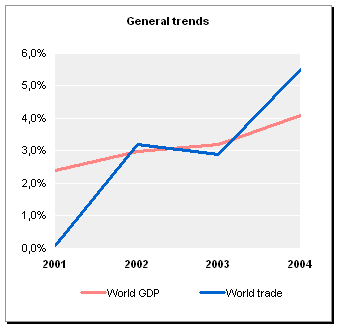
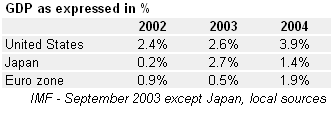
|
|
Freight rates
Dry bulk freight rates
literally took off to unprecedented heights, fuelled by
China's enormous needs for raw materials and other
primary products used to develop its infrastructures.
This take-off even accelerated in the second half of
the year.
Tanker
rates experienced impressive ups and down during the
year but resulted in an average level well above the
previous years. Container freights rates also marked a
strong progression.
|
|
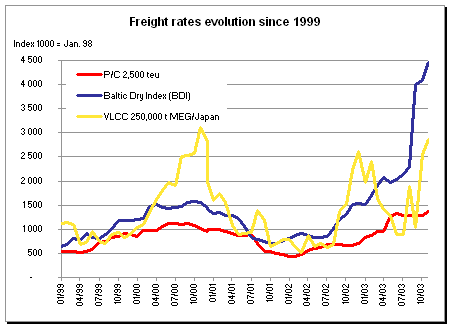
The robust levels of freight
rates in 2003 certainly helped to order and finance new
ships. The SARS epidemic and the Iraqi war were unable
to put a hold on this trend.
|
|
Orders |
 |
|
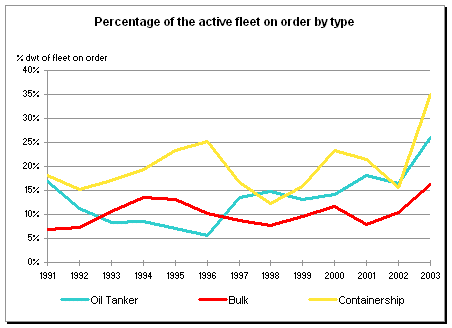
|
Tankers
With over 52.5 million dwt of
new orders, the year 2003 was particularly strong for
tankers, around two and a half times as much as in
2002. It is also far higher than the peak registered in
2000, which for reference was 34.3 million dwt. Without
any doubt, the shipwreck of the 'Prestige' brought a
change and pushed political and economic leaders to
adopt tighter regulations, accelerate the phasing-out
of old tankers and single-hulls, tighten inspections
and adopt more restrictive chartering practices.
As a result, the tanker
orderbook has been expanding and jumped from 46.6
million gt at the end of 2002 to 79.2 million gt at the
end of 2003. Ships on order represent about 26 % of the
fleet in service.
There has been a real rush
toward the shipyards for placing tanker orders.
Variations from one year to another are significant:
orders for product tankers of 25,000 to 50,000 dwt went
from 94 in 2002 to 238 in 2003, that for Panamax from
46 to 85, for Aframax from 44 to 106, for Suezmax from
18 to 49, and for VLCC from 16 to 57!
This year has seen a very
strong demand for ice-strengthened tankers, very often
for the highest ice class '1a' rating, which for
example allows ships to load crude or refined products
in the Gulf of Finland and the Sakhalin Islands, where
Russia is in the process of building new ports and oil
terminals. It is true that after a series of
particularly mild winters, operators were caught by
surprise that a large part of the Baltic became
ice-bound. The specification for ice-strengthened ships
has a considerable impact on the investment cost, since
it is not only a question of strengthening the hull but
also to install a more powerful engine that means also
to adapt all the auxiliaries, entailing an additional
10 % on the overall cost.
Numerous product tankers of
37,000 to 47,000 dwt have been ordered with a '1a' ice
class, as well as Aframax and Suezmax types. In view of
the extra costs, some owners have opted for a
combination of different ice class requirements ('1a'
for the hull and '1b' for the engine). It is
nonetheless probable, with the impressive increase in
Russian oil exports from the Baltic and the Black Sea,
that there will be stricter regulations imposed by
adjoining countries, which may create a need for other
types of tankers.
Some owners have designed
innovative ships to increase the safety of oil
carriage, offering their clients some original
solutions. For instance Stena has ordered a series of
six ships of a new type called P-Max, fitted with
double propulsion. These ships offer a number of
economic advantages: with the same length as a product
tanker of 47,000 dwt, namely 183 m, but a breadth of 40
m compared to 32.25 m, they can transport 65,000 tons
of products while retaining the same draught.
|

|
Containerships
With 26.7 million dwt, 518
ships for a total of 2.7 million teu, demand for new
containerships was extremely strong in 2003. The
numbers were by far superior to those of 2000, namely
13.7 million dwt when the world economy was
flourishing, and more than three times the figure for
2002, which was 7.1 million dwt. The tonnage on order
represents about 35 % of the active fleet in dwt terms.
Dominated by major Asian
shipbuilders, the orderbook for containerships extends
now up until 2007 comprising: 201 ships for 678,000 teu
scheduled for delivery in 2004, 236 ships for 875,000
teu in 2005, 177 ships for 820,000 teu in 2006 and 54
ships for 352,000 teu in 2007.
The most significant factor
for this year was essentially the size of the ships
ordered. For 35 ships in service in the category larger
than 7,500 teu (7,500 to 8,200 teu), we have seen 126
new orders during the year 2003. With the exception of
some series of ships placed with IHI and ships being
built at Odense for the account of Maersk-Sealand, all
the remaining ships will be leaving the four big Korean
shipyards (Hyundai, Samsung, DSME, and Hanjin).
One hundred and eight of
these ships have been designed with a 42.8 metres beam,
allowing them to load up to 17 rows of containers on
deck. A smaller number has a beam of 45.8 metres (18
rows) reaching the limit imposed, for the time being,
by the cranes available in the majority of container
terminals.
Some operators who run their
own 'hubs' have already anticipated that their port
equipment should in theory be able to handle ships of
greater breadth, with up to 22 container rows. Thus the
way seems to be opening for larger ships which future
generations may go up to 10,000, 12,000 or even 18,000
teu.
|
Bulk carriers
Demand was very strong in
2002 for large size bulk carriers (Capesize and
Panamax), with nearly 21.6 million dwt being ordered,
as much as in 1999. In 2003, this trend was even more
pronounced with 32.9 million dwt. This relatively
smaller performance compared to containers and tankers
can be explained by:
-
the full occupancy of
traditional shipyards dedicated to building this type
of ship which at the end of 2002 already was covered
until 2006,
-
the greater attraction for
builders towards containerships and tankers with higher
prices which allows them to increase their turnover,
-
the uncertainties linked to
the changing regulations concerning double-hulled bulk
carriers,
-
the resistance from buyers
during the first half of 2003 to accept price increases
being claimed by builders.
The orderbook for bulk
carriers is nonetheless on the rise and went from 28.6
million dwt end 2002 to 49.2 dwt end 2003. The tonnage
on order at the end of 2003 was about 16.2 % of the
active fleet in dwt terms.
The trend toward new types of
ships is continuing. Thus specialised builders of
Handymax bulk carriers, after having produced in 2002
'designs' for single-hull ships of 55,000 to 56,000 dwt
have proposed this year ships of 58,000 to 60,000 dwt.
The main dimensions do not vary much, with the length
remaining for the moment at 190 m and the breadth at
32.2 m, but the draught is higher and cargo cubic
capacity has increased. Chinese yards, Jiangnan,
Shanghai Shipyard and Bohai are building for China
Shipping bulk carriers of 57,000 dwt with a length of
200 m. It will be interesting to see if other owners
follow the movement, thereby creating a new category of
ships.
Some double-hulled Handymaxes
were ordered in China, notably with the yards Yangzhou
Dayang, Kouan, Mawei,
Xiamen and Zhejiang. However
builders and owners have most of the time gone for
single-hulls, as rules and regulations related to
double-hull design have not yet been completely
decided.
There was no significant
design evolution for Panamax bulk carriers but the
trend to build larger Capesize bulk carriers is
confirmed by the orders of ships of 200,000 and 230,000
dwt. The enormous needs for iron ore at competitive
freight rates could create a new interest for larger
ore carriers of 270,000 dwt or more. Interested
shipyards are fine-tuning their projects.
|
|
Specialised tonnage
Demand for specialised tonnage
has remained very weak with the exception of
car-carriers and LNG ships. Consequently shipyards
which have geared their operations to one type of ship
are facing some difficulties. Their idea was originally
good, since it was based on the principle of acquiring
a better control over the project and its cost, but in
very narrow markets, these yards encounter difficulties
when volumes of orders drop. It should be remembered
that specialised tonnage only represents a very small
fraction of the tonnage of standard ships built in the
world, both in volume and in number of ships.
|
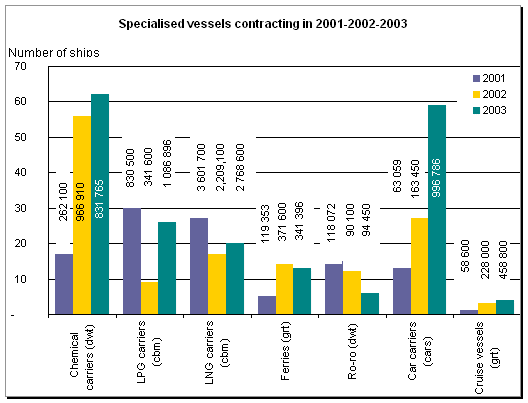
|
|
Prices |
|
A significant rise in the
price of tankers, bulk carriers, and containerships was
experienced in 2003. The increase was on average 20 %
(expressed in dollars).
Some observers are astounded
at the moderation of this increase taking into account
the enormous demand, but this is generally the case for
a number of industrial goods, which are not
mass-produced. This 'reasonable increase' is in fact
due to the diversity and the elasticity of supply which
shipbuilding offers.
|
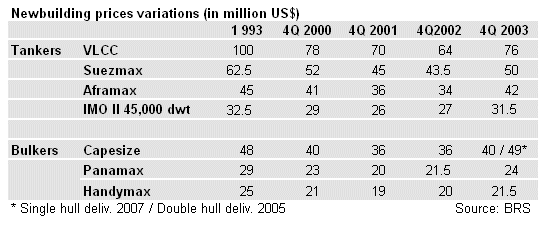
|
|
It seems that in the first
half of the year there was a constant but reasonable
increase in prices, principally justified by the
sustained demand, then in the second half the trend got
carried away.
|
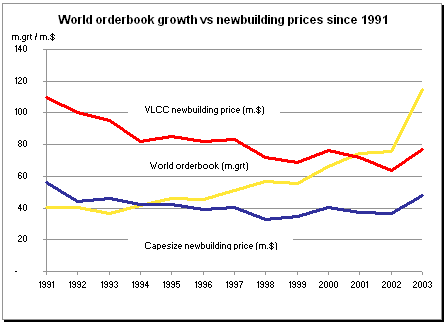
|
|
Other factors came into the
equation, sometimes triggering off threshold price
levels or dramatic variations in prices. First of all
the scarcity of available docks within a reasonable
delay, which created a fierce competition for the
earliest possible delivery dates and allowed shipyards
to play the bidding. There was a noticeable change in
behaviour: with builders demanding a better return,
owners were obliged to pay more if they wanted to make
the deal, whilst betting on the continued firmness of
freight rates.
Shipbuilders hedged their
positions between the three most common types of ships:
containerships, tankers, and bulk carriers (for a same
size of ship, they give priority to the most expensive
ships and to series), and only showed an interest in
low-added-value ships to satisfy their traditional
clients if the latter were prepared to pay substantial
premiums on the price.
The resale of ships still
under construction with prompt delivery dates started
multiplying, at prices systematically higher than the
price offered by the yards themselves for later
deliveries, which was essentially motivated by the hike
in charter rates notably in the bulk and oil sectors.
Strong demand was not the
only factor pushing prices up. Shipbuilders' own costs
increased particularly with the rise in raw materials
and energy prices. Steel prices more than doubled and
suppliers, very much sought after given the enormous
orderbooks, also pushed up their tariffs. Moreover, the
extended delivery dates meant that suppliers had to
incorporate additional margins to cover future and
unforeseen fluctuations of supply costs and exchange
rates.
Change in currency values also contributed to the rise
in newbuilding prices. For example the yen/dollar
exchange rate in January 2003 was 118.2 compared to
107.8 by the end of 2003 while euro/dollar was 0.95 in
January and 0.79 by year-end. Despite a fixed parity
between the Chinese currency and the dollar, Chinese
shipbuilders contracting in dollars buy a large part of
their equipment abroad (Europe, Japan, Korea) and the
decline in the dollar's value has increased the cost of
these imported items.
|
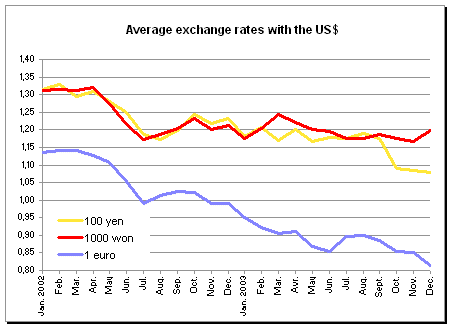
|
|
Specialised ships did not
enjoy the same increases as standard ships, due to a
less sustained demand. Shipyards which are building
these do not always have the capacity to quickly adapt
to other types of ships. Other builders who have this
capacity want nonetheless to keep their expertise. All
in all, this resulted in prices being kept down for
such ships and reduced margins for the builders,
despite facing increases in their costs. For instance,
the 2003 price for 145 000 cbm LNG carrier remained
roughly at the very low levels of 1999, namely about
$ 150/155 million.
The general increase in prices
seen in 2003 could continue in 2004, given the scarcity
of berths available, the depreciation of the dollar and
the rise in raw materials and equipment costs.
Notwithstanding, if the shipyards are fully booked,
their clients are also highly committed, and to order a
ship with a delivery date in 3 or 4 years time is a
gamble, albeit financed by the massive windfall profits
owners have extracted from charter rates, which reached
all time highs in 2003. The success of these future
deliveries depends for a large proportion on the
strength and stability of economic growth and above all
on the firmness of freight rates.
|
Shipping and Shipbuilding Markets in 2003
I N D E X
|